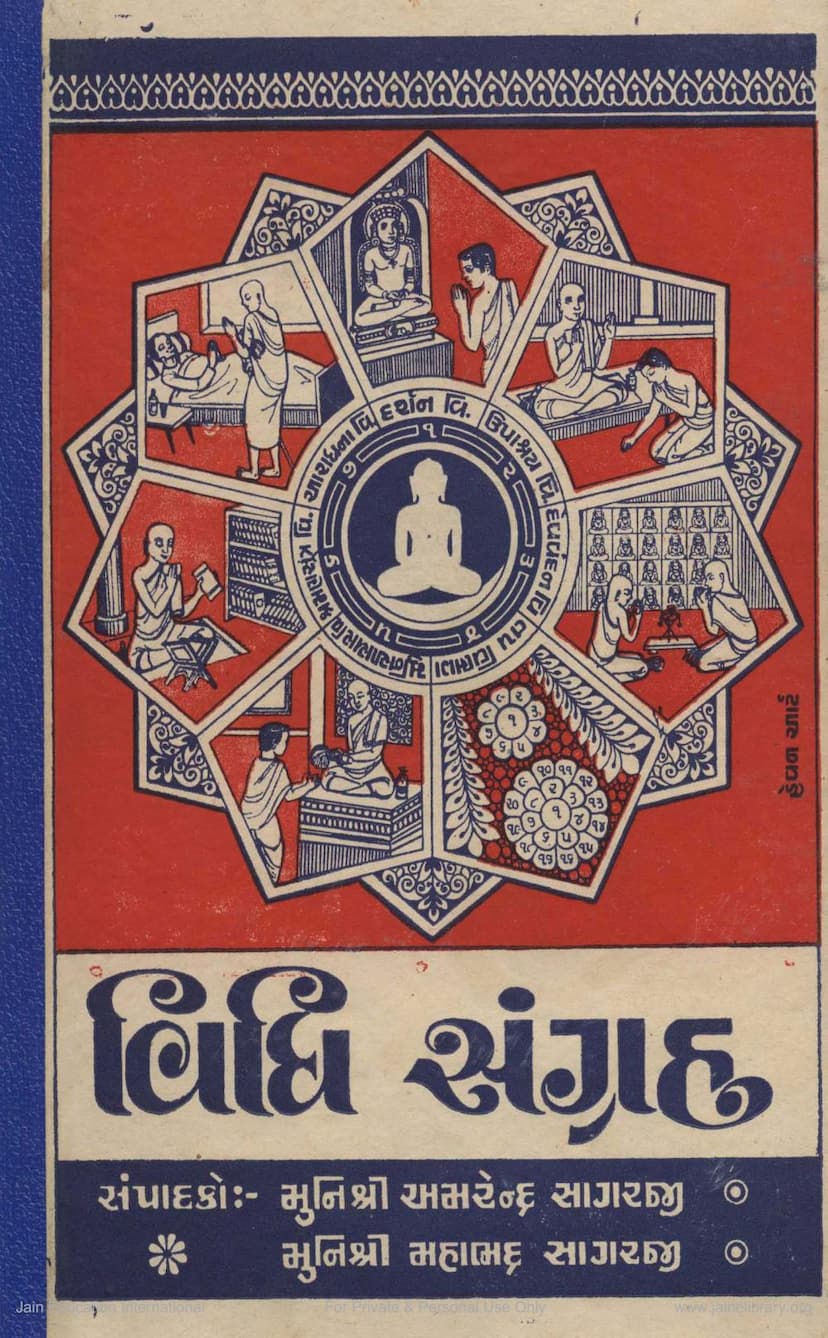Vidhi Sangrah
Added to library: September 2, 2025

Summary
"Vidhi Sangrah" (Collection of Rituals) by Muni Aksharendra Sagarji and Muni Mahabhadra Sagarji, published by Amarchand Ratanchand Zaveri, is a comprehensive Jain text detailing various rituals, observances, and practices. The book aims to provide a structured guide for followers of Jainism, covering a wide spectrum of religious activities.
Key Aspects and Structure:
The book is meticulously organized into seven sections, each dedicated to a specific area of Jain practice. These sections are symbolically represented in the book's cover design, with the central image of the Siddha (liberated soul) signifying the ultimate goal of all Jain endeavors.
-
Darshan Vibhag (Section of Vision/Appearance): This section focuses on rituals related to visiting and venerating Jain temples and the divine figures enshrined within. It likely includes procedures for circumambulation, bowing, and paying respects to the Tirthankaras.
-
Upashray Vibhag (Section of Monastic Abode): This part deals with observances performed under the guidance and in the presence of Jain monks and nuns (Shramanas). This could include rituals like Samayika (meditation), Pratikraman (confession and repentance), and learning scriptures from spiritual mentors.
-
Devavandan Vibhag (Section of Deva-worship): This section details the various ways in which celestial beings (Devas) and Tirthankaras are venerated. It might cover pujas (acts of worship) like Ashtaprakari Jin Puja (worship with eight types of offerings) and Snana Puja (ritual bathing of idols).
-
Tap Vibhag (Section of Austerities): This extensive section likely outlines the procedures for performing various Jain fasts and austerities, possibly numbering around 50 different types. This could include details on specific rituals like Vishasthanak Tap (austerity related to twenty auspicious places) and Navapad Tap (austerity dedicated to the nine sacred entities).
-
Muni Achar Vibhag (Section of Monastic Conduct): This part focuses on the code of conduct for Jain monks and nuns, potentially covering rituals related to initiation (Diksha Vidhi) and other essential aspects of their spiritual journey.
-
Shraman Sutra Vibhag (Section of Monastic Codes): This section likely includes the essential sutras (aphorisms or codes) that guide the daily lives and practices of monks and nuns, possibly including texts for new initiates or those seeking deeper understanding.
-
Aradhana Vibhag (Section of Worship and Devotion): The final section is dedicated to devotional practices. This might include hymns (Stavans) like Punya Prakash Stavana, worship of specific deities like Padmavati Aradhana, and rituals associated with the final stages of spiritual practice or rituals for those nearing their end of life.
Content Highlights:
The book is noted for its comprehensive collection of nearly 90 different rituals. It emphasizes the importance of performing actions correctly according to scriptural injunctions (Vidhi) to achieve the desired spiritual results (Siddhi). The text explains the definition and significance of "Vidhi" (method or ritual) and uses scriptural references and everyday analogies to illustrate its necessity. It also includes detailed explanations of various pujas like the Ashtaprakari Puja (worship with eight substances) and the process of performing Chetyavandan (veneration of shrines). The book also provides explanations of the purpose behind these rituals, linking them to the purification of the soul and the attainment of spiritual merit.
Key Themes:
- Adherence to Rituals (Vidhi): A central theme is the importance of following prescribed rituals correctly for spiritual progress.
- Holistic Approach: The book covers rituals for monks, nuns, laymen, and laywomen, encompassing all aspects of Jain spiritual life.
- Detailed Guidance: The text aims to provide practical and detailed instructions for performing various religious acts.
- Spiritual Goal: All rituals and observances are ultimately directed towards the attainment of liberation (Siddha-pada).
Context and Significance:
"Vidhi Sangrah" serves as a valuable resource for Jain practitioners seeking to understand and perform their religious duties accurately. By compiling a vast array of rituals and practices, it acts as a guide for both common followers and those dedicated to a more rigorous spiritual path, ensuring the continuity and correct practice of Jain traditions. The book's multiple editions indicate its popularity and usefulness within the Jain community.
This comprehensive summary provides a broad overview of the "Vidhi Sangrah," highlighting its structure, key themes, and significance within Jainism.